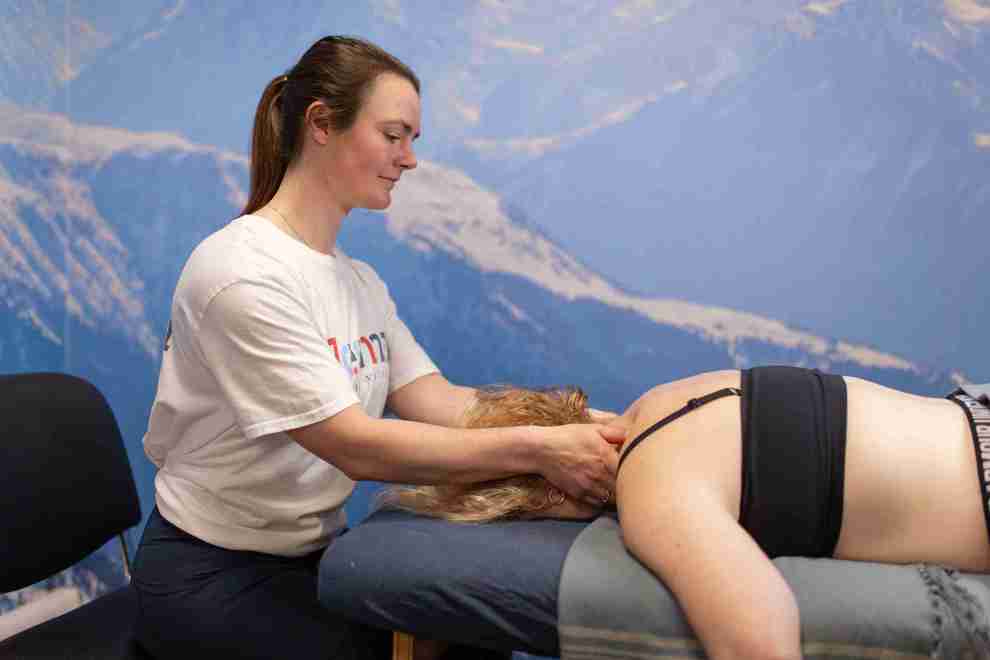Caitlin McNeice is a remedial, sports and scar massage therapist with a masters in amputation rehabilitation. She explains the latest thinking behind the relatively new field of scar tissue massage
There can’t be many people in the UK who know more about veterans’ rehabilitation than Caitlin McNeice. Not only is she a qualified remedial, sports and scar massage therapist with a masters degree in amputation rehabilitation, but her partner of nearly 10 years, Scott McNeice, is a military amputee and Blesma Member.

“I’m a sporty person and knew I wanted to work with people, so after university I began working in a sports and remedial massage clinic,” says Caitlin. “I was also lucky enough to work at the Glasgow 2014 Commonwealth Games, where I was attached to the military flag team for the medal ceremonies. I was so impressed with those guys that I joined the Reserves.
“I met Scott when he was based in Stirling. He was into archery and had a shoulder injury. I knew I could help people with injuries like his, and being a Reservist gave me that added military perspective.”
A different direction
Partly because of her burgeoning career and partly due to logistics when Scott began struggling with his knee, Caitlin didn’t join the military full-time.
“Our relationship was still quite new when Scott went into hospital,” she says.
“Much of my work was still in Scotland, so we scraped by for a while. Logistics were a nightmare, and there was a lot of driving. Scott got a serious infection and at one point I found him sitting on the sofa, shaking because he was so ill. So my military career never quite got going. It just didn’t fit with my life.”
Caitlin’s experiences looking after Scott led her to find out more about amputation and scars. In 2018, as part of a scar course, she learned how massage can help to heal damaged tissue, and she has since worked with a number of Invictus Games athletes.
“The scar is the tip of the iceberg – the small area that’s visible on the surface. To assist the healing process I’m looking at what’s going on under the surface”
“When you lay down scar tissue, it wants to knit the area back together as quickly as possible, and the fibres are much thicker and stiffer. Scar massage is still a relatively new approach, but it is about understanding those different structures. We are learning more about how the connective tissue that covers your whole body – the fascia – mixes with scars and muscle.
“With massage, you can change the appearance of the scar tissue, especially in scars that are less than two years old, but the scar itself will only regain up to 80% of its original function. The scar is the tip of the iceberg – the small area that’s visible on the surface. To assist the healing process I’m looking at what’s going on under the surface; where is there tension, heat, a lack of tissue…”
Caitlin followed the scar course with a masters degree in amputation rehabilitation.
“After Scott competed in the Invictus Games in 2018, I struggled a lot with anxiety. Doing the degree helped me come to terms with things. It had been such a journey with Scott, and then we had to find out all about prosthetics. Between us we have a lot of practical, real-world knowledge and medical understanding.
“I completed the degree part time and wrote my dissertation on the experiences of snowsports veterans; how did the activity change or improve their lives? It was very interesting.”
Helping healing hands
Caitlin has also worked with veterans in Bosnia through a charity called the Healing Hands Network, which has been sending massage therapists out to the Balkans for the last three decades.

“I went out there for a couple of weeks and worked with a mix of people,” says Caitlin. “The benefit of having someone who cares can really make a difference. I worked with a guy who had been shot in the chest. Afterwards, he said he felt as though he could stand up tall again. I also worked with a woman who had been shot in the head and arm when she was six years old. And there were older clients who didn’t have physical issues but had a lot of emotional trauma.”
On top of all this, Caitlin is writing a book. “It’s a kind of field guide to amputation, with a focus on the practical and mental health elements; things that have helped Scott and myself, and that you or your partner can do. And we are chatting to Blesma to see if we can work together to provide therapy for Members who are struggling with pain.
“The Association has been great for us. It was the first charity to get in touch with Scott and ask if he would like to chat. It has been there the whole way.”
For more on how Caitlin might be able to help, email stokestherapy1@gmail.com
We can help
We are dedicated to assisting serving and ex-Service men and women who have suffered life-changing limb loss or the use of a limb, an eye or sight. We support these men and women in their communities throughout the UK. Click the link below to find out the different kinds of support we offer.
Get Support
Leave a comment
Join fellow Members and supporters to exchange information, advice and tips. Before commenting please read our terms of use for commenting on articles.